| Group | Anatolian (with Hittite, Luwian etc.), Late Anatolian (with Carian, Lycian, and Sidetian) |
| Geography | Spoken in Lydia, in West Asia Minor, with the capital in Sardis |
| History | When the Hittite Empire fell, Anatolian city-states started a new epoch of Indo-European settlers of Asia Minor. These cities were inhabited both by Indo-European Anatolians and non-Indo-European nations of the region, like Hatti, Assyrians, Aramaeans. Before the 8th century B.C. descendants of Hittites and Luwians moved farther to the West, to the shores of the Aegean Sea. Lydia was situated in the Western part of Asia Minor, on the river Galis. It was first mentioned by Homer already in the 8th century B.C. under the name Maeonia. It was celebrated for fertile soil, rich deposits of gold and silver. Lydia became most powerful under the dynasty of the Mermnadae, beginning about 685 BC. In the 6th century BC Lydian conquests transformed the kingdom into an empire. Under the rule of King Croesus, Lydia attained its greatest splendor. The empire came to an end, however, when the Persian ruler Cyrus the Great captured Sardis about 546 BC and incorporated Lydia into the Persian Empire. After Alexander, Lydians were assimilated by Greeks, the Greek language and the Greek culture, and though Strabo in the 1st century A.D. talks about Lydians as an ethnic item, they did not have much of their original language at that moment. |
| Phonetics | Lydian phonetics is more complicated than that of Hittite: nasal vowels [a], [e] appeared together wsith the sound [o]; consonant system has several palatals for [s'], [t'], [d'], [l'], [n'] used very widely . Those palatals, as we can believe, came from the combination of i + a consonant. The Hitite p became a spirant f in Lydian. |
| Nominal Morphology | Nouns are declined in pronominal declension, the Hittite noun declension was almost completely lost. The accusative case was replaced by dative in the meaning of direct object of the verb. At all, the noun had two genders (common and neuter), five cases and two numbers. |
| Verbal Morphology | Two original Hittite types of conjugation are still seen in Lydian. The past tense, one of the two tenses of the language, was formed by the suffix -l, an Indo-European participle element. The verb is conjugated in number and person, prefixed verbs are met frequently. |
| Lexicon | The lexicon was influenced by aboriginal peoples much, later by Greek influence. |
| Writing | Lydian alphabet |
| Close Contacts | A direct descendant of Hittite, Lydian was very close to Carian and Sidetian. |
| Sample | ak-it qed fas'fnu ak-at qL fakantrov ak-m-L-is qis Ditollad
bitad fak-m-L-it-in qLdn-k artimu-k katsarlokid ak-it edkok tqratad
kot-ad amu mitridastas' ftamNidN ak-s' qis mN tamN
uN bavDnas'od buk in mtrid buk
bidN qik int akmL qed med tams' uN ak-ad artimus'
bifers't.
So-here, what I have and-this to whom trust and-so-to-him-who harm does and-so-him both Kildans and Artemis will revenge, and will be-done as-this I, Mitridast, decide, and he, who my prescription to-be made, ignores or breaks it, or any harm does, and-so-to-him the prescription to-be made, will order and-this Artemis will-define. (Sardis) |
| Picture |  |
| More info |